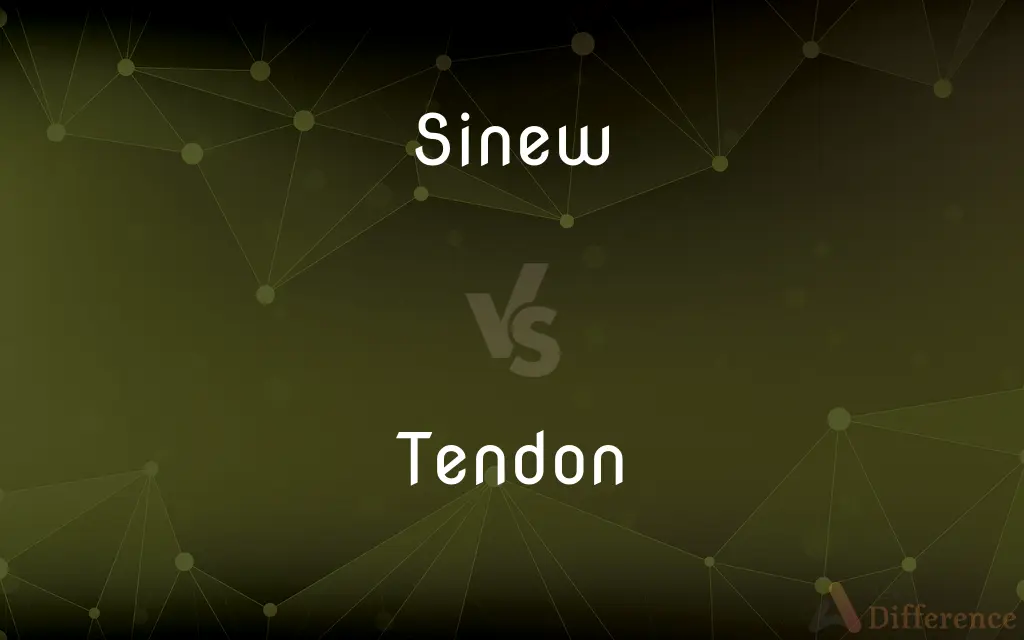Sinew vs. Tendon — What's the Difference?
By Tayyaba Rehman & Maham Liaqat — Updated on April 3, 2024
Sinew refers broadly to tendons or ligaments, emphasizing strength and resilience, whereas tendons specifically connect muscles to bones, facilitating movement.

Difference Between Sinew and Tendon
Table of Contents
ADVERTISEMENT
Key Differences
Sinew is a term often used to describe tendons or ligaments, highlighting their role in providing strength, support, and resilience to the body. It is more commonly found in literary or historical contexts, where it symbolizes physical strength and durability. On the other hand, tendons are a specific type of connective tissue that serve a crucial function in the musculoskeletal system by attaching muscles to bones, thereby enabling movement.
While sinew can refer to any fibrous tissue that contributes to bodily strength, tendons are defined by their specific anatomical function. Tendons are composed of dense fibrous collagen tissue, designed to withstand tension while transmitting the force generated by muscles to bones, leading to motion. Sinew, in its broader usage, may also encompass ligaments, which connect bones to each other and stabilize joints, although this is less precise.
The distinction between sinew and tendon becomes clearer when considering their representation in various contexts. Sinew is often used metaphorically to describe underlying strength or the fundamental aspects of physical power. Tendons, however, are discussed in a more scientific and anatomical context, focusing on their role in the mechanics of movement and their properties as connective tissues.
Injuries to these tissues also highlight their differences in medical and rehabilitative contexts. While "sinew" might be used in a general sense to refer to injuries of strong, fibrous tissues, medical professionals specify injuries as tendonitis, tendinopathy, or ligament sprains, reflecting a more precise understanding of the structure and function of tendons.
Despite their differences, both terms underscore the importance of connective tissues in providing structural support, enabling movement, and contributing to the physical capabilities of organisms. Whether discussing the poetic strength symbolized by sinew or the biomechanical functions of tendons, both play integral roles in the anatomy and physiology of the body.
ADVERTISEMENT
Comparison Chart
Definition
Broad term for tendons or ligaments
Connective tissue attaching muscle to bone
Context
Literary, historical, or general
Scientific, anatomical
Function
Symbolizes physical strength and resilience
Facilitates movement by transmitting force
Composition
Can refer to various strong, fibrous tissues
Dense fibrous collagen tissue
Anatomical Role
More generalized
Specific to muscle-bone connection
Injuries
Used broadly, not specifying type
Specific injuries like tendonitis
Compare with Definitions
Sinew
In historical contexts, refers to actual tendons used for bowstrings or bindings.
Traditional archers crafted their bows with sinew for strings.
Tendon
A band of fibrous connective tissue that connects muscle to bone.
The athlete tore his Achilles tendon during the race.
Sinew
Sometimes used to describe the tough, fibrous nature of meat.
The cook removed the sinew to tenderize the meat.
Tendon
Subject to various specific injuries, such as tendonitis.
Repetitive motion can lead to tendonitis, requiring rest and treatment.
Sinew
Fibrous tissue connecting muscle to bone or bone to bone; symbolizes strength.
The ancient warriors were admired for their sinew and courage.
Tendon
Varied in size and strength depending on their location and function.
The patellar tendon is crucial for knee extension and mobility.
Sinew
Often used metaphorically to describe the essence or core strength of something.
Hard work is the sinew of success.
Tendon
Essential for movement, transmitting the force from muscle to bone.
Strong tendons contribute to explosive athletic performance.
Sinew
Can refer broadly to physical or moral strength.
The community's sinew was tested by the natural disaster.
Tendon
Can be strengthened and conditioned through specific exercises.
Eccentric exercises are effective for strengthening tendons.
Sinew
A tendon.
Tendon
A tendon or sinew is a tough high-tensile-strength band of dense fibrous connective tissue that connects muscle to bone and is capable of withstanding tension and transmit the mechanical forces of muscle contraction to the skeletal system. Tendons are similar to ligaments; both are made of collagen.
Sinew
Vigorous strength; muscular power.
Tendon
A band of tough, inelastic fibrous tissue that connects a muscle with its bony attachment.
Sinew
Often sinews The source or mainstay of vitality and strength
"Good company and good discourse are the very sinews of virtue" (Izaak Walton).
Tendon
(anatomy) A tough band of flexible but inelastic fibrous collagen tissue that connects a muscle with its bony attachment and transmits the force which the muscle exerts.
Sinew
To strengthen with or as if with sinews.
Tendon
(biology) The hamstring of a quadruped.
Sinew
(anatomy) A cord or tendon of the body.
Tendon
(construction) A wire or bar used to strengthen prestressed concrete.
Sinew
A cord or string, particularly (music) as of a musical instrument.
Tendon
A tough insensible cord, bundle, or band of fibrous connective tissue uniting a muscle with some other part; a sinew.
Sinew
(figuratively) Muscular power, muscle; nerve, nervous energy; vigor, vigorous strength.
Tendon
A cord or band of inelastic tissue connecting a muscle with its bony attachment
Sinew
That which gives strength or in which strength consists; a supporting factor or member; mainstay.
Sinew
A nerve.
Sinew
(transitive) To knit together or make strong with, or as if with, sinews.
Sinew
A tendon or tendonous tissue. See Tendon.
Sinew
Muscle; nerve.
Sinew
Fig.: That which supplies strength or power.
The portion and sinew of her fortune, her marriage dowry.
The bodies of men, munition, and money, may justly be called the sinews of war.
Sinew
To knit together, or make strong with, or as with, sinews.
Wretches, now stuck up for long tortures . . . might, if properly treated, serve to sinew the state in time of danger.
Sinew
A cord or band of inelastic tissue connecting a muscle with its bony attachment
Sinew
Muscular strength
Common Curiosities
What is the main function of sinew in the body?
Sinew, in a broad sense, refers to tendons or ligaments, contributing to the body's strength, support, and ability to move.
What are common tendon injuries?
Common tendon injuries include tendonitis and tendinopathy, often resulting from overuse or strain.
Is there a difference in treatment for sinew vs. tendon injuries?
Treatment is specific to the type of injury; tendon injuries may require rest, physical therapy, or surgery, reflecting a more precise approach than the general term "sinew" might imply.
Can sinew regeneration occur?
Regeneration of sinew, or tendons, is limited; healing can be slow and may result in scar tissue, which affects functionality.
Can sinew be used to refer to ligaments?
Yes, sinew can broadly refer to ligaments as well, although it is more accurately used to describe tendons.
How does a tendon work?
Tendons work by transmitting the force generated by muscle contraction to bones, facilitating movement.
How can tendons be strengthened?
Tendons can be strengthened through progressive load exercises, which gradually increase the stress on the tendon to improve its strength and resilience.
What role does sinew play in historical contexts?
Historically, sinew was used for practical purposes such as making bowstrings, threads, or bindings, showcasing its importance in survival and technology.
Why is tendon health important for athletes?
For athletes, healthy tendons are crucial for efficient force transmission, injury prevention, and optimal performance in their sports.
What advancements have been made in tendon injury treatment?
Advancements include regenerative medicine techniques like stem cell therapy and platelet-rich plasma (PRP) injections to improve healing and functionality.
Share Your Discovery

Previous Comparison
Pathfinder vs. Trailblazer
Next Comparison
Department vs. OfficeAuthor Spotlight
Written by
Tayyaba RehmanTayyaba Rehman is a distinguished writer, currently serving as a primary contributor to askdifference.com. As a researcher in semantics and etymology, Tayyaba's passion for the complexity of languages and their distinctions has found a perfect home on the platform. Tayyaba delves into the intricacies of language, distinguishing between commonly confused words and phrases, thereby providing clarity for readers worldwide.
Co-written by
Maham Liaqat













































